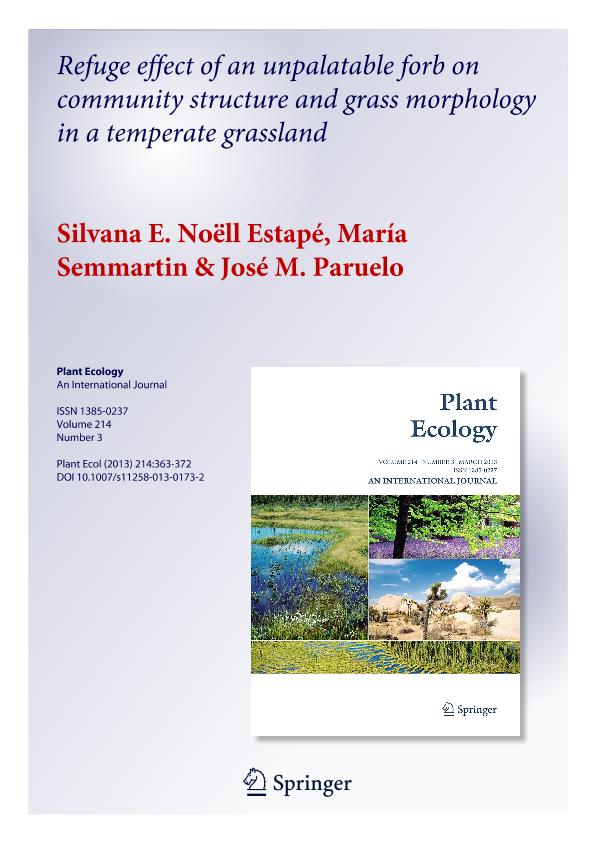Mostrar el registro sencillo del ítem
dc.contributor.author
Nöell Estapé, Silvana E.
dc.contributor.author
Semmartin, María Gisela

dc.contributor.author
Paruelo, José

dc.date.available
2016-02-16T20:14:55Z
dc.date.issued
2013-02
dc.identifier.citation
Nöell Estapé, Silvana E.; Semmartin, María Gisela; Paruelo, José; Refuge effect of an unpalatable forb on community structure and grass morphology in a temperate grassland; Springer; Plant Ecology; 214; 3; 2-2013; 363-372
dc.identifier.issn
1385-0237
dc.identifier.uri
http://hdl.handle.net/11336/4230
dc.description.abstract
The role of unpalatable plant species as biological antiherbivore refuges for palatable species is well-documented at community level particularly in harsh environments. In productive sub-humid temperate grassland subjected to domestic grazing, we examined the protective effect of Eryngium horridum on plant community structure and floristic composition, and evaluated whether these changes impacted on a number of morphological traits of grasses, related to grazing resistance. We also investigated, for a palatable grass species (Stipa neesiana) the existence of morphological differences between protected and unprotected plants and if this eventual variation was either plastic or genetic. The study consisted of a field survey where we compared paired patches, with and without E. horridum, and a greenhouse experiment where we evaluated individuals of S. neesiana coming from both patch types over a 11 months period. Patches dominated by E. horridum had lower richness and cover of forbs than patches without the forb, and similar richness but greater cover of cool-season tussock palatable grasses, which suggests a protective role on the latter. Grasses in these patches also had longer blades and sheaths and lower specific leaf area. The morphological differences of S. neesiana individuals collected from both patch types disappeared after 11 months growth in a common environment which revealed significant phenotypic plasticity in this species. These results suggest the existence of plant-to-plant facilitation in a productive ecosystem not only at community level, through changes in species richness and the promotion of palatable grasses, but also at population level, through plastic changes in aboveground morphological traits. Both facilitation and plasticity, would contribute to the persistence of threatened palatable grasses in the heavy grazed productive ecosystems.
dc.format
application/pdf
dc.language.iso
eng
dc.publisher
Springer

dc.rights
info:eu-repo/semantics/openAccess
dc.rights.uri
https://creativecommons.org/licenses/by-nc-sa/2.5/ar/
dc.subject
Eryngium Horridum
dc.subject
Indirect Facilitation
dc.subject
Plan-Plant Interactions
dc.subject
Phenotypic Plasticity
dc.subject
Positive Relationships
dc.subject
Stipa Neesiana
dc.subject.classification
Ciencias de las Plantas, Botánica

dc.subject.classification
Ciencias Biológicas

dc.subject.classification
CIENCIAS NATURALES Y EXACTAS

dc.subject.classification
Ecología

dc.subject.classification
Ciencias Biológicas

dc.subject.classification
CIENCIAS NATURALES Y EXACTAS

dc.title
Refuge effect of an unpalatable forb on community structure and grass morphology in a temperate grassland
dc.type
info:eu-repo/semantics/article
dc.type
info:ar-repo/semantics/artículo
dc.type
info:eu-repo/semantics/publishedVersion
dc.date.updated
2016-03-30 10:35:44.97925-03
dc.journal.volume
214
dc.journal.number
3
dc.journal.pagination
363-372
dc.journal.pais
Alemania

dc.journal.ciudad
Berlin
dc.description.fil
Fil: Nöell Estapé, Silvana E.. Universidad de la República. Estación Experimental Dr. Mario A. Cassinoni. Facultad de Agronomía, Departamento de Producción Animal y Pasturas; Uruguay
dc.description.fil
Fil: Semmartin, María Gisela. Consejo Nacional de Investigaciones Científicas y Técnicas. Oficina de Coordinación Administrativa Parque Centenario. Instituto de Investigaciones Fisiológicas y Ecológicas Vinculadas a la Agricultura; Argentina
dc.description.fil
Fil: Paruelo, José. Consejo Nacional de Investigaciones Científicas y Técnicas. Oficina de Coordinación Administrativa Parque Centenario. Instituto de Investigaciones Fisiológicas y Ecológicas Vinculadas a la Agricultura; Argentina. Universidad de Buenos Aires. Facultad de Agronomía. Departamento de Métodos Cuantitativos y Sistemas de Información; Argentina
dc.journal.title
Plant Ecology

dc.relation.alternativeid
info:eu-repo/semantics/altIdentifier/url/http://link.springer.com/article/10.1007%2Fs11258-013-0173-2
dc.relation.alternativeid
info:eu-repo/semantics/altIdentifier/doi/http://dx.doi.org/10.1007/s11258-013-0173-2
dc.relation.alternativeid
info:eu-repo/semantics/altIdentifier/issn/1385-0237
Archivos asociados
